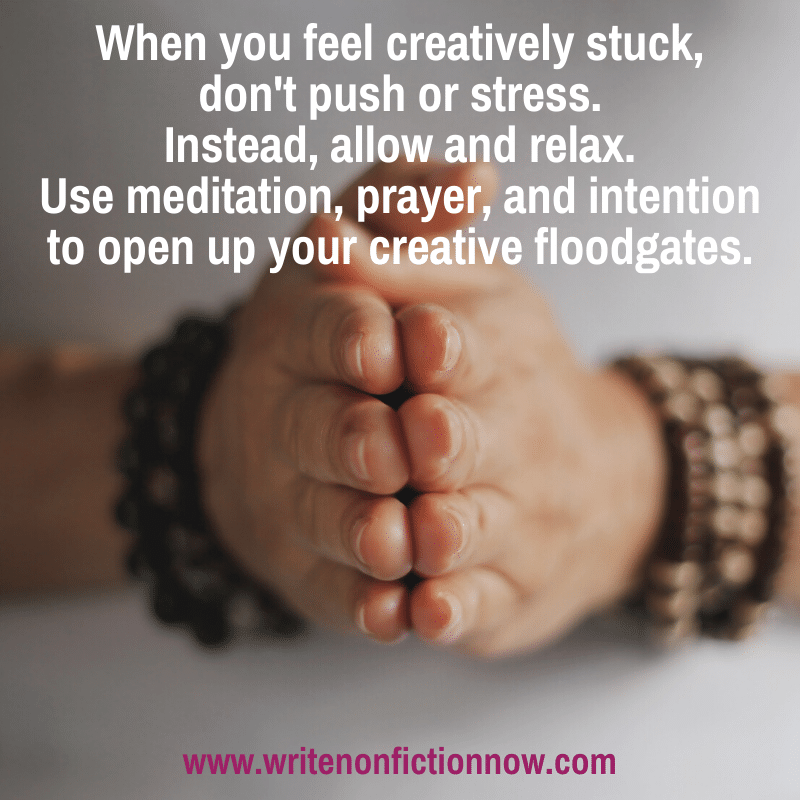 You’ve been sitting at your desk for 15 minutes staring at the screen. So far, you haven’t written a word. Even when your mind happens to throw you ideas, they don’t seem worth pursuing. So you continue to sit there, frustrated because you just don’t know what to write.
You’ve been sitting at your desk for 15 minutes staring at the screen. So far, you haven’t written a word. Even when your mind happens to throw you ideas, they don’t seem worth pursuing. So you continue to sit there, frustrated because you just don’t know what to write.
Have you been there and done that? Pretty annoying, right, especially since 15 minutes can turn into 30, 45, or even an hour or more?
The more you try to force yourself to come up with an idea for your next article, blog post, or chapter, the more creatively blocked you feel…and get.
What if you could stop forcing it and, instead, just allow an idea to come to you? What if you could let go of your feelings of pressure or stress and relax into a place of creativity?
It’s possible.
Let Go and Allow
Like the song from the movie Frozen, you can, indeed, let it all go. From the place of emptiness, ideas will flow to you easily and quickly.
If this sounds all airy-fairy, well, you could see it that way. After all, I’m talking about meditation. That said, most people these days accept meditation as a sound practice for stress release, productivity, creativity, and general well being.
I want to add an additional element to the meditation, though—a spiritual aspect.
If you don’t see yourself as a spiritual person or don’t believe in God, Source, Creator, or whatever you might call It, that’s fine. There’s a way to open and allow using the process I describe below without any type of religious or spiritual belief.
Let me explain…
Create Space for Creativity
Your mind is a busy place. According to the National Science Foundation, an average person has about 12,000 to 60,000 thoughts per day. Of those, 80 percent are negative and 95% are repetitive thoughts.
That means you think the same thoughts pretty much day in and day out. I bet that when you sit down to type, your negative thoughts come into play—thoughts like, “I don’t know what to write,” “I don’t have any good ideas,” and “No one will want to read what I write.”
That’s not helpful if you are looking for new ideas or want to tap into your creativity.
If you want to allow in more ideas and get your creative juices flowing, you need to slow down and quiet the noise in your head. That’s where meditation comes in.
Use Meditation to Find Ideas
You can’t really stop your thoughts. Most meditators will tell you that their thoughts may slow, or they may become more aware of them. Still, their mind rarely becomes totally quiet during a meditation period.
 However, since you can only think about one thing at a time, the key to quieting your brain lies in deciding what to think about. For this simple meditation, I suggest you think only about breathing.
However, since you can only think about one thing at a time, the key to quieting your brain lies in deciding what to think about. For this simple meditation, I suggest you think only about breathing.
Specifically, use a tried and true, simple meditation technique that requires you only that you focus on your breath.
Breathe in. Breathe out. Breathe in. Breathe out.
That’s all you think about while you meditate. Breathe in. Breathe out.
There are other ways to meditate, but this technique is simple, and anyone can do it. More than that, it works. It gives your mind a “bone” to “chew on,” and that stops all those thoughts for a while.
Once your mind gets quiet (or quieter), you’ve created a space for something new to exit. And in that space, an idea will appear.
Give it time… Don’t be impatient. Continue breathing without thinking about the need for an idea. Just relax and breathe.
Wait for it…the idea will come.
Ask for What You Want
Now comes the spiritual part. Again, you don’t need to believe in a God of any type for this.
If you don’t believe in God or have a broader concept of divinity, consider this an intention-setting practice. Begin your meditation session by saying aloud or in your head something like, “It is my intention during this meditation period to open to my creative nature and remove all blocks to my creativity. It is also my intention to discover an idea that inspires and motivates me and serves my readers and me.” Use your own words.
If you do believe in God, add to your meditation practice a simple prayer. When you begin meditating, mentally say something like, “God, please help me open to my creative nature. Remove all blocks to my creativity. And help me know what to write. Show me or bring me an idea that supports my highest good and the highest good of my readers. Amen.” Again, use your own words.
Ask for what you want, and then breathe. Just breathe. Focus on your breath, and an idea will appear in the space you created.
Be Ready to Write
When I do this meditation practice, I like to have my computer close at hand. In fact, I meditate with my hands on the keyboard of my laptop. Then, when an idea hits, I begin to type—often with eyes closed. (I peek to see if my hands are on the right keys, then close my eyes again.)
You could use a journal for this process. I just find it easier to type with eyes closed than to write.
Sometimes, while I meditate, a thought pops into my head. It seems like the makings of an idea…so I follow it. I allow myself to start typing and just see where it goes. More often than not, that’s the idea I needed.
I first put this technique into play as part of my morning journaling routine. I had just finished reading Conversations with God, and I wondered what would happen if I allowed myself to hear and speak with God.
At first, I would ask a question, just as Neale Donald Walsch did in the book. And I would wait, hands on the keyboard, for an answer. Then I would type whatever came into my head.
Was it God talking to me? I don’t know. But I would get some pretty interesting answers!
Watch and Listen
I enjoyed the process and found it helpful. Therefore, I decided to try something similar when I needed to write a new blog post or article or when I sat down to work on a book project.
I’d set an intention, ask a question, or pray, and then I’d breathe and listen for the “Still Small Voice” that might speak to me in the silence.
Be aware, however, that just because you are a wordsmith, you might not hear anything at all. The idea you seek may not show up as words in your head begging to be put onto paper.
Instead, you might get a feeling. Or you might see an image in your mind’s eye. Possibly, a memory will pop up.
Don’t dismiss these! Each one may hold the kernel of the idea.
In fact, write everything down that comes to you. And after you complete your meditation, you can ponder each more carefully and decide if it will provide the foundation of your next written work.
Employ Timed Meditation Periods
If you are wondering how long to meditate, here’s your answer: not long.
I could say, “Meditate for as long as it takes to get an idea,” but then you might spend hours sitting there waiting. Instead, set a timer.
Try 20 minutes. If you get an idea sooner, great! If you don’t, extend the time to 30 minutes.
Just like a writing deadline pushes you to become focused and productive, a timed meditation period tells your mind—or God—that you are serious about finding that idea and getting on with your writing in a set amount of time.
With a timer set, you will find ideas consistently show up before the end of your meditation period. An open-ended meditation period might leave you sitting there all day!
Give meditation coupled with prayer or intention a try. You’ll find it enhances your creativity. The process also will teach you to relax and quiet your mind, and that’s a surefire way to open the creative floodgates and keep ideas flowing.
Have you used meditation, prayer, and intention to increase your creativity? Tell me in a comment below. And please share this post with another writer.
 Would you like to write and publish nonfiction work, like articles, blog posts, books, or reports…and become a successful author? Join the Nonfiction Writers’ University. Get the basic education you need and the Author Coaching to help you succeed as a nonfiction writer. Enjoy a 30-day trial membership for only $1. If you’ve felt the desire to get coached and be supported as you pursue authorship, this program is for you. Participate in monthly group Author Coaching sessions and gain access to an extensive archive of writing and publishing resources.
Would you like to write and publish nonfiction work, like articles, blog posts, books, or reports…and become a successful author? Join the Nonfiction Writers’ University. Get the basic education you need and the Author Coaching to help you succeed as a nonfiction writer. Enjoy a 30-day trial membership for only $1. If you’ve felt the desire to get coached and be supported as you pursue authorship, this program is for you. Participate in monthly group Author Coaching sessions and gain access to an extensive archive of writing and publishing resources.